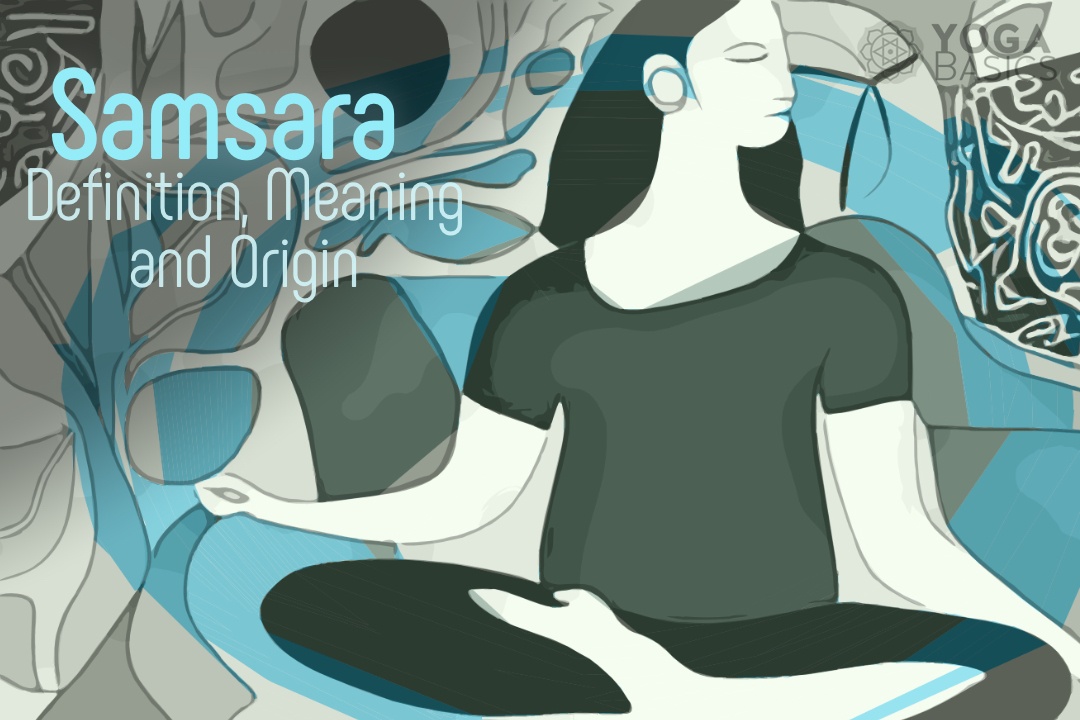

Finding salvation from the suffering inherent in human life has been at the core of the spiritual quest of yoga. Whether it is freeing ourselves from negative emotions, physical pain, and mental agitation, yoga gives us the tools to break out of our cycles of suffering. Ultimately, escaping samsara—the endless cycle of birth, death and rebirth—is at the heart of a yogi’s path to finding freedom from suffering.
What is samsara?
The Sanskrit term samsara translates as “wandering through,” or “aimless wandering.” Samsara is the concept of reincarnation, a cyclic existence where our spirit or individual soul is trapped in an endless wheel of life, death and rebirth.
Yogis believe the soul reincarnates over and over again unless it has achieved moksha, or liberation. The concept of reincarnation has been around since ancient times, and is part of the beliefs of Buddhism, Jainism, and Sikhism.
These traditions describe samsara as a cyclical state of being where we have no choice but to experience pain, sorrow, and frustration. Yet we do have the opportunity to choose how we respond to our current life experiences. The next incarnation of one’s life is dependent upon the karma taken in one’s current and previous lives. If we don’t choose wisely, we accumulate more bad karma, which will further trap us in this cycle of suffering.
In the Hindu and yoga traditions, samsara is a journey of the atman, the pure consciousness of the universal Self, through various bodies, realms, and states of being. The only way to break free from the endless cycle of reincarnation is to achieve moksha, or enlightenment.
Also Read : Homemade Hot Chocolate
Attachment, desire, aversion, and ignorance are the root causes of suffering and the creation of negative karmic deeds. We accumulate positive and negative karma based on our thoughts, words, and actions. If we have accumulated enough negative karma, we will be reborn into lower realms of existence. If we have accumulated sufficient positive karma, we will eventually reach higher planes of existence.
The accumulation of karma and the strengthening of attachment binds and entangles one’s jiva or individual soul in a web or “sea of samsara,” which leads us into further suffering. But when we practice yoga, we begin to see these patterns of attachment and aversion as they arise within ourselves. As long as we remain attached to life, we will experience repeated births and deaths. But when we let go of attachments, we free ourselves from suffering and can begin to break free from the cycle of reincarnation. This leads to freedom or moksha, the ultimate goal of uniting jiva with Brahman, the universal soul.
Origin of samsara
The concept of samsara was first discussed in the early Upanishad texts, but it was not a fully formed philosophy until approximately the 5th century BC. It soon became a central concept in all of the developing Indian religions and eastern philosophies. The Bhagavad Gita, composed in the second century BCE, further explained and linked the concept of samsara with the practices of yoga.
This Self is never born, nor does it ever perish; nor having come into existence will it again cease to be. It is birthless, eternal, changeless, ever-same (unaffected by the usual processes associated with time). It is not slain when the body is killed. Just as an individual forsaking dilapidated raiment dons new clothes, so the body-encased soul, relinquishing decayed bodily habitations, enters others that are new. —The Bhagavad Gita (2:20-22)
Samsara, maya and avidya
Maya (illusion or ignorance) is our memories, perceptions, judgments, and other psychological distortions of the world around us. This distorted sense of reality presents as the sense of separation between the self and the universe and the psychological filter that colors our experiences. Maya reinforces the ego, strengthens attachments, and defines our individual story. Thus maya perpetuates our suffering and also makes it difficult to see and uncover the source of our suffering.
Avidya has a similar meaning, but is different from the concept of maya. Maya is a universal state of illusion, whereas avidya is spiritual ignorance. Avidya is the misconception of our true reality, believing that the temporary is eternal, the impure is the pure, and pleasure to be painful. This false and distorted representation of reality is the primary klesha, the mental patterns that create suffering and bind us to samsara.
Ignorance keeps us trapped in the illusions of the mind. As soon as we recognize these mental constructs as false, we free ourselves from the chains of avidya. Removing these veils of ignorance and delusion allows us to see the truth, which is that we are all interconnected. The more we remove these veils, the closer we get to enlightenment.
Samsara and moksha
Moksha is the path of liberation from suffering and the attainment of self-realization. It’s a state of pure consciousness where there is no separation between self and the divine. Moksha is the only way to break free from the continuous cycle of birth and death.
While good karma, spiritual practice, and devotion to the divine can help liberate us from the cycles of rebirth, ultimately, we must work towards achieving moksha. In order to achieve this state of liberation, we need to purify our minds through meditation, devotion, and contemplation. Moksha is the primary pathway to break free of the endless cycle of samsara and attain freedom and liberation.
Yoga practice for samsara
The main goal of yoga is to free us from the cycle of samsara, yet this is an incredibly difficult practice. Yoga teaches us to let go of our egoistic desires and attachments and embrace the truth that there is no separation between us and everything else; we are one with everything. This is achieved through the cultivation of wisdom (prajna), compassion (karuna), self-inquiry (viveka) and equanimity (upeksa).
More importantly, yoga teaches us to accept and delight in the play of samsara instead of renouncing it. We learn to live in harmony with the cycles of nature, to live in the here and now, and to enjoy each moment of our lives.
Conclusion
Yoga was created as a path to freedom from suffering, whether that meant finding a better life in the world or escaping the cycle of death and rebirth. Through regular practice, we develop the skills necessary to break free from the bonds of karma, remove the causes of suffering, and achieve moksha.
Even on an intellectual level, we can benefit from learning and understanding the philosophy of samsara. Understanding the mechanics of reincarnation helps us step back and see how our actions affect our future lives, and how our karmic deeds and past lives affect our psychological patterns and mental suffering. Knowing about samsara gives us a greater perspective on everyday life and helps us understand why we do what we do. It also motivates us to lead a virtuous life, acts of good karma, and spiritual pursuits contribute to a better future, whether in this life or future lives.





